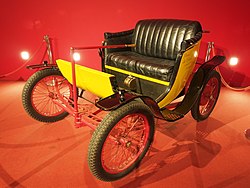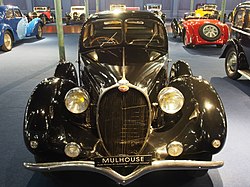List of Bugatti prototypes
From Wikipedia, the free encyclopedia
This is a list of prototype vehicles created by Bugatti that never reached or were never intended for serial production.
This article needs additional citations for verification. (June 2022) |
Type 29
The Type 29 racing car, which began development in 1921, used a new 2 L (1991 cc/121 in³) straight-8 engine which would subsequently be used in the Type 30 production model. Four of the cars were entered in the 1922 French Grand Prix where they performed well, with three of the four completing the full distance behind the sole other surviving car, a FIAT, from an original field of 18 cars.[1]
Type 36
The Type 36 racer was produced in 1925, and used a new 1.5 L (92 cu in) straight-8 engine. With a 60 mm × 66 mm (2.4 in × 2.6 in) bore and stroke, the engine later saw use in the Type 39A, though the Type 36 itself was more of an experiment. At first, the rear axle was bolted directly to the frame with no springs. In 1926, Bugatti added both rear springs and a supercharger to the Type 36. This was the experimental base for the Type 35C.
Type 45 and Type 47
The Type 45 racing car's U16 engine was made up of 2 parallel 8-cylinder banks, hence the 8 exhaust runners per side, and had two crankshafts. The Type 45 and similar Type 47 "Grand Sport" were to become a new generation of cars from Bugatti. The engine, a 3-valve SOHC design, was based on the 3-valve straight-8 from the Type 35. Two versions were made: a 3.0 L (180 cu in) version fitted to a Type 47 prototype shared the Type 36's cylinder dimensions, while the Type 45 prototype used a stroke of 84 mm (3.3 in) for a displacement of 3.8 L (230 cu in). Output would have been 200 to 250 hp (150 to 190 kW) with a Roots-type supercharger.
The entire vehicle was unique, including its chassis. The Type 45 used a 2,600 mm (100 in) wheelbase, while the Type 47 was stretched to 2,750 mm (108 in). Both had a 1,250 mm (49 in) track.
- Type 45 front right
- Type 45 front
- Type 45 front left
- Type 47 left
- Type 47 front left
- Type 47 engine left
- Type 47 engine right
Type 56
The Type 56 was an electric vehicle. Originally designed for private use by Ettore Bugatti as a factory runabout, popular demand from previous customers convinced him to build more examples.[2] The number built is controversial; six seems the most likely answer.
The Type 56 was a tiny 2-seat open car very much in the style of turn-of-the-century horseless carriages or voiturettes. Power came from a single 28 amp electric motor producing 1 hp (0.75 kW). Energy was stored in six 6 volt accumulators in series for a total of 36 volts. The motor was mounted directly to the frame and drove the rear wheels through gears. Electric braking was integrated, and both hand- and foot-brakes operated on rear wheel drums. Four forward speeds were available, and the vehicle could accelerate to 28 km/h (17.4 mph). Steering was via a tiller.
Ettore Bugatti's personal Type 56 is part of the collection at the Musée National de l'Automobile de Mulhouse.
- Type 56 front right
- Type 56 front
- Type 56 front left
Type 64
The Type 64 was an Atlantic-style coupe produced in 1939 with papillon [French for "butterfly"] doors, designed by Jean Bugatti. It was fitted with a 4.4 L (270 cu in) 2-valve DOHC straight-8 engine and rode on a 3,300 mm (130 in) wheelbase. Production was begun on three cars, but only one body was finished before Jean Bugatti's death in 1939; a second was completed in 2012.[3][4][5][6]
- Type 64 front right
- Type 64 front
- Type 64 front left
Type 73C
Summarize
Perspective
Started in 1943 and completed in 1947 after WWII, the Type 73C was to be a comeback for Bugatti, but the death of Ettore Bugatti in August of that year doomed the project. An engine-less Type 73 was shown at the 1947 Paris Motor Show two months later. Although five 73C chassis had been constructed in Paris, only one body was completed, and at least three engines and one complete car were assembled and tested by the factory. Serge Pozzoli stated that he visited the Bugatti factory at Rue Debarcadere in Paris, where he saw a demonstration car which was fitted with a scaled-down body similar to the pre-war Type 50BIII "Cork Car". All the cars were dismantled and taken to Molsheim after Ettore Bugatti's death.
The Type 73C used a new 1.5 L (92 cu in) straight-4 engine with 4 valves per cylinder and a dual overhead camshaft. This was a new design with a 76 mm (3.0 in) bore and 82 mm (3.2 in) stroke, wet cylinder liners, a detachable cylinder head, and a single cast iron exhaust manifold. Much to the chagrin of Bugatti purists, the Type 73 used off-the-shelf hex fasteners rather than the custom-designed parts used in all previous cars.
The five Type 73C chassis were sold off after the company exited automobile production. Most were later assembled, and one (number 2) was even given a body based on the original Bugatti drawings.
There are a few prototype Type 73 Bugatti models:
- Type 73 touring two- or four-seater; DOHC straight-4 with four valves per cylinder
- Type 73A touring two- or four-seater; SOHC straight-4 with three valves per cylinder
- Type 73C Grand Prix single seater; similar engine to the Type 73
- Type 73B touring two- or four-seater; similar engine to the Type 73A
- Type 73C
- Type 73C with engine cover off
- Type 73A front left
- Type 73A front right
- Type 73A rear right
Type 251
The final resurgence of the original Bugatti was the Type 251, completed in 1955. Designed by Gioacchino Colombo of Ferrari fame, it was powered by a new 2.5 L (150 cu in) straight-8. Uniquely, this engine was mounted transversely behind the driver. For the first time in a Bugatti, an oversquare engine was used, with a 76 mm (3.0 in) bore and 68.5 mm (2.70 in) stroke. The use of a de Dion tube rear suspension was also a novelty for the company, though it was in vogue at the time. The Type 251 was entered in the 1956 French Grand Prix, driven by Maurice Trintignant,[7] but was not competitive and retired after 18 laps.
- In front of the Bugatti factory in Molsheim
- With driver Maurice Trintignant
- Right side
- Cockpit
- Rear
- Without the front cover
- Engine
- Front
Technical data
| Type 45 | Type 47 | Type 29 | Type 36 | Type 64 | Type 251 | Type 73A | Type 73C | |
|---|---|---|---|---|---|---|---|---|
| Engine: | U16 engine | Front mounted 8-cylinder in-line engine | 4-cylinder in-line | |||||
| displacement: | 3800 cm³ | 2986 cm³ | 1991 cm³ | 1495 cm³ | 4433 cm³ | 2486 cm³ | 1462 cm³ | 1488 cm³ |
| Bore x stroke: | 60 x 84 mm | 60 x 66 mm | 60 x 88 mm | 52 x 88 mm | 84 x 100 mm | 76 x 68.5 mm | 70 x 95 mm | 76 x 82 mm |
| Max power at rpm: | 200-250 hp at 5 000 rpm | 70 hp at 3 800 rpm | 55 hp at 5 000 rpm | 155 hp at 5 000 rpm | 275 hp at 9 000 rpm | 120 hp at 5 000 rpm | 310 hp at 6 000 rpm | |
| Valve control: | 1 overhead camshaft, 3 valves per cylinder, SOHC | 2 overhead camshafts, 2 valves per cylinder, DOHC | SOHC, 3 valves per cylinder | DOHC, 4 valves per cylinder | ||||
| Compression: | 2 Roots compressor | Naturally Aspirated | Roots | Naturally Aspirated | Roots | |||
| Carburetor: | 2 Zenith 36 | Zenith 36 | Stromberg EE22 | 4 double Weber’s | Weber 36 | |||
| Upload: | ||||||||
| Gearbox: | 4-speed manual | 5-speed manual | 4-speed manual | |||||
| suspension front: | Rigid hollow shaft with semi-elliptical leaf springs running through the shaft | Rigid H-shaped axle with semi-elliptical leaf springs | Straight rigid solid axle with forward-pointing quarter-elliptical leaf springs | Rigid axle with semi-elliptical leaf springs running through the shaft | ||||
| suspension rear: | Rigid axle with inverted quarter-elliptical leaf springs | Rigid axle without suspension (rubber blocks only) | Rigid axle with inverted quarter-elliptical leaf springs | The Dion axle live | Rigid axle with inverted quarter-elliptical leaf springs. | |||
| Brakes: | drums, all-round | |||||||
| Chassis & body: | Pressed steel ladder | Tube chassis | Pressed steel ladder | |||||
| Wheelbase: | 260 cm | 275 cm | 240 cm | 250 cm | 330 cm | 218 cm | 240 cm | |
| Dry weight: | 1100 kg | 825 kg | 750 kg | 1265 kg | 750 kg | 1200 kg | 700 kg | |
| Top speed: | 193 km/h | |||||||
References
Wikiwand - on
Seamless Wikipedia browsing. On steroids.

























